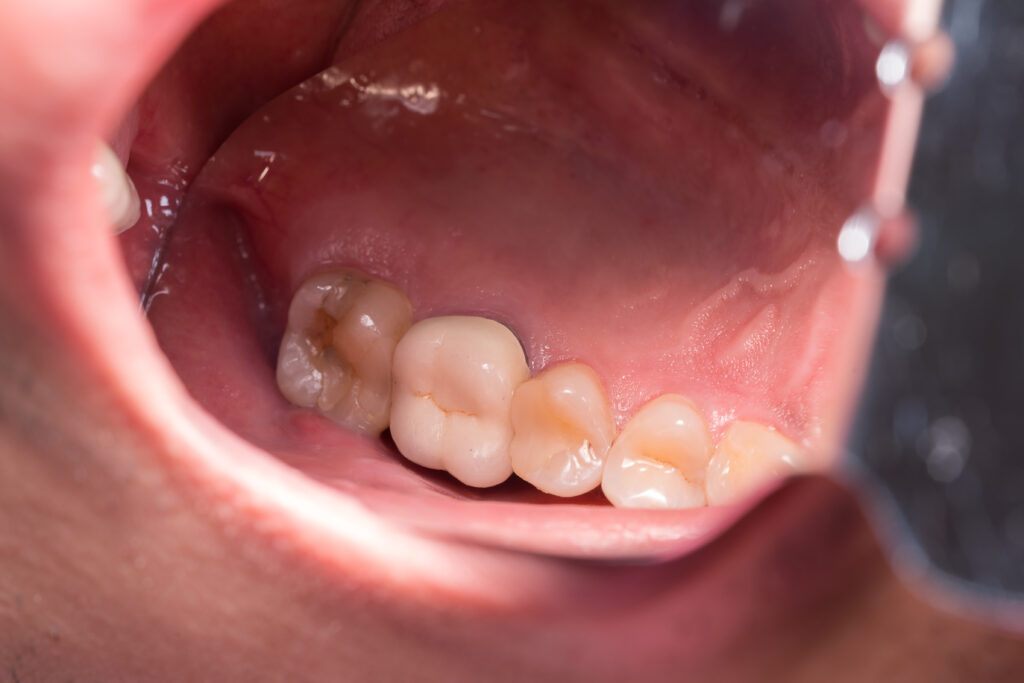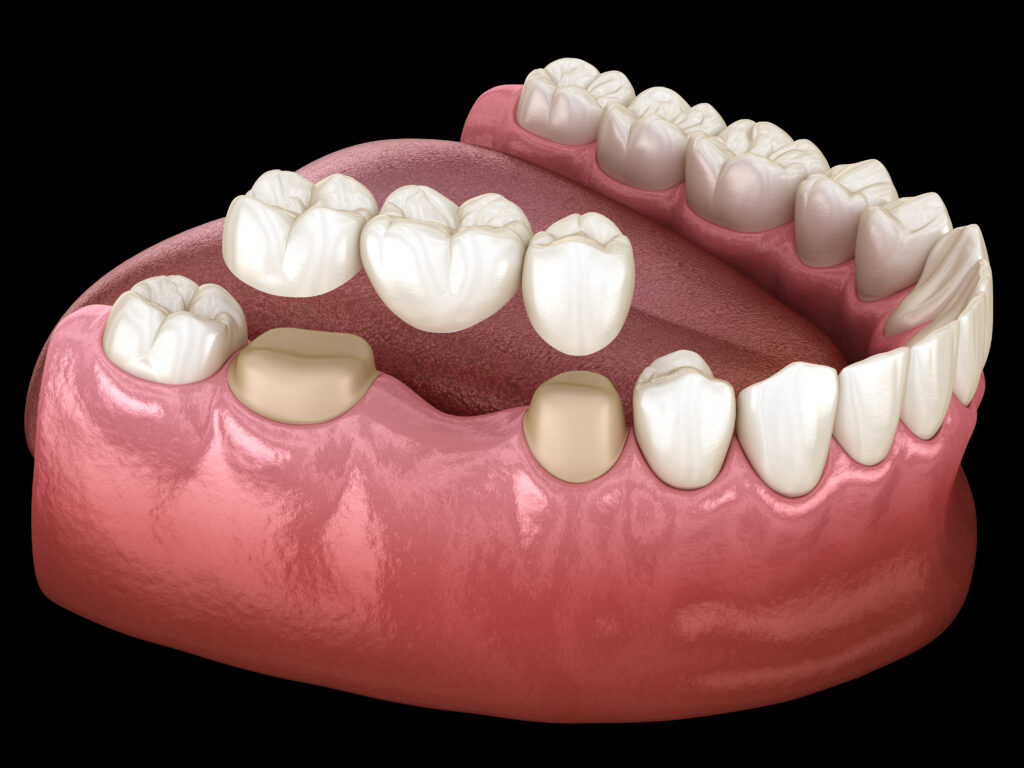Crowns And Bridges
- Home
- Crowns And Bridges

Understanding Dental Crowns
A Solution for Preserving Natural Teeth
Dental crowns are a versatile solution designed to restore a damaged or fractured tooth's form, function, and aesthetics.
By acting as a 'cap' placed over existing teeth above the gum line, a dental crown can help make teeth stronger and protect them from further damage.
Crowns are often used following root canal treatment or with dental implants to replace missing teeth.
Our dental clinic in Perth employs state-of-the-art technology and collaborates with reputable labs to ensure that these crowns are of the highest quality and craftsmanship.
Different Types of Dental Crowns
When it comes to dental crowns, there is no one-size-fits-all. There are several types to choose from, and the right one depends on your needs and preferences.
Ceramic Crowns: Ceramic crowns are known for their natural appearance and are often used for restoring front teeth.
Porcelain Fused to Metal: These crowns offer a good balance of durability and natural-looking aesthetics.
Gold and Metal Alloys: Known for their strength and longevity, these crowns are often used for back teeth where the forces of chewing and grinding are most significant. Gold alloys are less commonly used today primarily due to aesthetic considerations.
All-Porcelain Crowns: These crowns are ideal when aesthetics are a top priority because they can offer the most natural appearance.
Composite Resin: These crowns are made from plastic and fine glass particles and can be colour-matched to other teeth. While composite resin crowns are more affordable and require less removal of the natural tooth structure compared to other types, they are also less durable. They may not be suitable for molars or individuals who grind their teeth.
Zirconia Crowns: Zirconia is a strong material that can withstand wear and tear. It is also biocompatible, meaning it is accepted by the body and less likely to cause allergic reactions.
Reasons Why You May Need a Dental Crown
Dental crowns are used for a variety of reasons. You may need a crown if you have a damaged tooth that needs to be reinforced, a weak tooth that needs protection from breaking, or a tooth that is severely discoloured or misshapen.
Crowns also cover dental implants or hold a dental bridge in place.

Dental Crown Procedure
First visit – Examination and preparation: At the first visit, your dentist will examine the tooth to ensure it can support a crown, then start making a crown. The tooth receiving the crown is numbed and reshaped along the chewing surface and sides to make room for the crown. If a large area of the tooth is missing due to decay or damage, the dentist may use a filling material to “build up” the tooth to support the crown.
Making the impression: After the tooth has been reshaped, the dentist will make an impression of the tooth, as well as the surrounding teeth, by having you bite down on a soft paste or using a digital scanner. The impression or scan is sent to a dental lab, where your crown will be custom-made.
Temporary crown: While your permanent crown is being made, which usually takes two to three weeks, the dentist will place a temporary crown made of acrylic or metal to protect the prepared tooth.
Second visit: Placement of Permanent Crowns: During the second visit, the dentist will remove the temporary crown and check the fit and colour of the permanent crown. If everything is acceptable, a local anaesthetic will be used to numb the tooth, and the new crown will be permanently cemented in place.
Follow-up: After the procedure, you may experience sensitivity and irritation for a few days. You should continue to clean around the crown as you would with a natural tooth. Maintaining a good oral hygiene routine is crucial to prolong the life of your dental crown, which includes regular brushing, flossing around the crown, and visiting your dentist for check-ups and professional cleanings.
Discover Dental Bridges
Dental bridges, true to their name, bridge the gap left by one or more missing natural teeth. This dental restoration method involves one or several false teeth held in place by dental crowns cemented onto the natural teeth or implants on either side of the gap.
Not only does a dental bridge replace missing teeth, but it also helps maintain the shape of your face and distribute the forces in your bite properly by replacing missing natural teeth.

Dental Bridge Procedures: Filling in the Gap Left By Missing Teeth
Getting a bridge requires two or more visits to the dentist.
The dentist prepares the two healthy teeth on either side of the gap during the first visit. These teeth are reshaped to accommodate the crowns holding the bridge in place.
Next, the dentist makes an impression or digital scan of your teeth, which is sent to a dental laboratory where your bridge will be made.
During the second visit, your custom-made bridge is set in place and adjusted to ensure a proper fit. The bridge consists of two crowns that cover the prepared teeth and hold the false teeth in place.
Reasons Why You May Need a Dental Bridge
A dental bridge can be ideal if you’re missing one or multiple teeth. A dental bridge replaces these teeth to help you regain a healthy and aesthetically pleasing smile.
Bridges can also prevent the surrounding teeth from shifting out of position and causing additional dental health problems.
There are several types of bridges, including traditional bridges and cantilever bridges.
Traditional dental bridges are the most common and involve creating one crown for the tooth or implant on either side of the missing tooth, with a pontic in between.
Cantilever bridges are used when there are adjacent teeth on only one side of the missing tooth or teeth.
Maintaining a good oral hygiene routine is essential to prolong the life of your dental bridge and preserve your oral health, including brushing twice a day, flossing daily, and regular check-ups with your dentist.
With the help of experienced dentists, dental bridges can provide a functional, durable, and aesthetic solution to the problem of lost teeth, enhancing your smile and confidence.
Choosing Between a Dental Crown or a Bridge
Choosing one of these treatment options largely depends on your unique dental situation and goals.
A dental crown could be your best option if you have a damaged or weakened tooth with a healthy root. By fitting over the top of your existing tooth, a crown restores its shape, size, and function, preventing further damage and preserving the tooth’s structure.
On the other hand, if you’re faced with a gap caused by one or more absent teeth, a dental bridge may be the right choice. By spanning the space where the tooth once was, a bridge restores your ability to chew and speak properly, maintains the shape of your face, and prevents your surrounding teeth from shifting out of position.
While both crowns and bridges are effective solutions, they address different challenges.
Discussing your options with our Acts Dental trusted dental professionals can guide you to the decision that best fits your needs, ensuring a restored and confident smile.
Experience High-Quality Dental Crowns and Bridges at Acts Dental in Perth: Your Solution to Replacing A Missing Tooth
At Acts Dental, we’re committed to providing top-notch porcelain dental crowns and bridges, ensuring an ideal solution for replacing missing natural teeth.
Leveraging our extensive expertise and unwavering dedication, we deliver personalised, patient-centric dental care, focusing on maintaining and restoring the health and beauty of your smile.
We are Bupa preferred provider, Medibank preferred provider, HBF preferred provider, HCF preferred provider, and Nib preferred provider in Perth, ensuring that you receive the highest benefits and best prices with us, up to the annual limits of your health insurance.
Don’t let a missing tooth hold you back. Call us on (08) 9474 5083 to schedule your consultation today and embark on a transformative journey towards a radiant, confident smile.
